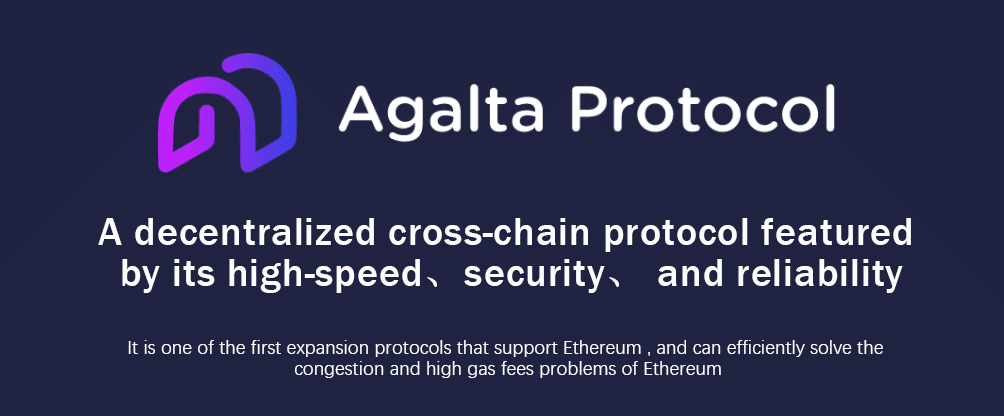Agalta Protocol: A Layer 2 Solution with the Best Overall Performance
Since its invention in 2016, Ethereum has become the most active and busiest blockchain network after years of repaid development. It is the undisputed NO.1 public chain in all perspectives, including richness of ecology applications, on-chain assets scale, token security and other core indicators.
In 2021, with the emerging of digital currency bull market in the past few months, the transaction frequency of digital currencies deployed in the Ethereum network increased massively, resulting in a significant increase in network usage, especially the bursting in DeFi area. This makes a desperate lack of the original throughput.
For a long time, the entire crypto community has been working hard to solve the throughput and high gas fees problem of Ethereum. One of the major solutions is Ethereum 2.0, which will increase TPS greatly. But is it possible to fix this from another perspective? The answer is yes, it is Layer 2.
About Layer 2
As we all know , the biggest weakness of ETH is the performance. ETH uses full nodes ,which led to low speed and congestion during transactions. ETH came up with the solution of sharding to improve its performance, means to divide Ethereum blockchain into several shards, put nodes in different shard to participate in accounting and consensus. After sharding, Ethereum become a number of relatively smaller blockchains, and the amount of nodes on each shard is significantly reduced. Thus improve work efficiency greatly.
However, sharding based on current situation causes great challenges for development and upgrades, as Ethereum is working constantly everyday and already has a lot of nodes and data.

What is Layer 2? Literally , it refers to the second layer of network. The logic is to transfer and process transactions from Ethereum’s main chain Layer 1 (L1) to Layer 2( L2), then send results back to Layer 1 for confirmation. We call this solution Ethereum Layer 2.
Simply put, Layer 2 develops another blockchain outside the Ethereum main chain, transfers transactions on Ethereum to Layer 2 for further processing, and sends results or briefing back to Ethereum blockchain. The theoretical TPS of L2 reaches 2000-4000, which surpasses Visa’s processing capacity-1700 transactions per second. Therefore, many people believe that the L2 solution is the hope for Ethereum to win the future.
At present, Layer 2 ecological construction has been carried out in full force, and design schemes in different types have received support from a certain amount of community users. However, the trilemma (i.e. decentralization, security and scalability, only two options are achievable) remains an unavoidable issue for most schemes. However, Agalta Protocol provides another thinking to solve this for the market.
About Agalta
Agalta is a decentralized cross-chain protocol featured by its high-speed, security, and reliability. It is one of the first expansion protocols that support Ethereum , and can efficiently solve the congestion and high gas fees problems of Ethereum .Through side chain expansion technology, Agalata extends the internet to existing and future blockchain, Agalta helps developers to build Dapp quickly, and carry out large-scale commercial applications.
Agalta Protocol is committed to the construction of the public chain Layer-2 cross-chain DeFi ecosystem, will launch multi-chain cross-chain research and development plan as scheduled, and gradually open Layer-2 high-speed cross-chain network of Binance Smart Chain, Huobi Eco-Chain, Polkadot Main Chain, OKT and other public chains. As well as the enterprise development toolkit. One click fork of Defi projects and products on Ethereum will also be available here. And Agalata will become a cornerstone of the global public chain Defi eco-system.

In today’s market, Layer 2 solutions like Rollup and State Channel are emerging, including some repetitive functions. Many investors tend to be speculators and ignore some common problems of projects. For example, in the economic model of Optimistic Rollup Protocol, each batch sequencer of epoch needs a smart contract called bond administrator to be marked as collateral. To become a collateral sequencer, a fixed amount of ETH has to be added to the contract. This economic model can prevent the sequencer from becoming abnormal, but it does not fix the potential risk that the verifier may try to send a large number of fraud proofs to the blockchain in different batches (Forcing a large amount of L1 calculations ).
Celer, a representative project of the State Channel. Even though the side chain channel in its network can significantly reduce required collateral deposit, it still has to be proportional to channel numbers and replay capacity of a singal channel (such as payment). This requires massive liquidity in Celer network to ensure normal running of State Channel. Besides, usually the State Channel requires users from both sides to be online all the time, otherwise fairness and security cannot be guaranteed. This kind of availability lackness limits State Channel’s application greatly.
Agalta Protocol Technical Advantages
Agalta Protocol carried out in-depth research and innovation to solve the common problems mentioned above. And proposed a new generation of Layer 2 Agalta solution: namely , a high-performance cross-chain Protocol that supports multi-chain ecology. Specifically, it has the following highlights.
- Decentralized network: An efficient, safe, and credible decentralized side chain network. The first layer-2 expansion protocols that support Ethereum features scalability and robustness.
- Cross-chain anchoring: AGAT provides a two-way anchored Aga-adapter (adapter) for ETH and other ERC-20 tokens to transfer them to the Agalta chain and provide an EVM-compatible execution environment for DeFi applications.
- AMM model: The newly optimized AMM model automatically prices assets by using the pricing algorithm in the smart contract and creates a liquidity pool for each transaction token. The AMM pool provides liquidity for asset transactions in an automated manner.
- Ultra-high TPS: On the high-performance cross-chain network based on the Agalta API framework, the theoretical TPS performance is as high as 140,000+, far exceeding the existing blockchain transaction performance.
- 0 Gas fee: The unique layer-2 architecture avoids network congestion and the high gas fee. The 0 gas fee allows users to trade freely without worrying about high handling fees and network delays
- Real-time transactions: All transactions are migrated to Layer-2. Users can conduct real-time transactions without waiting for the confirmation time of a block.
- Privacy and security: Based on the advantages of blockchain distributed structure, anonymity and non-tamperable data, the data privacy of transaction users is fully protected, which avoids personal data leakage and data loss

Layer 2 Solutions Comparision
Agalta Protocol stands out among many projects with excellent overall performance. It is very suitable as the best L2 solution that supports high-performance applications under the main net Ethereum L1.
For more news and latest updates please feel free to join Agalta Protocol community in Telegram, Twitter and Medium.
Disclaimer: This publication is sponsored. Coinspeaker does not endorse or assume responsibility for the content, accuracy, quality, advertising, products, or other materials on this web page. Readers are advised to conduct their own research before engaging with any company mentioned. Please note that the featured information is not intended as, and shall not be understood or construed as legal, tax, investment, financial, or other advice. Nothing contained on this web page constitutes a solicitation, recommendation, endorsement, or offer by Coinspeaker or any third party service provider to buy or sell any cryptoassets or other financial instruments. Crypto assets are a high-risk investment. You should consider whether you understand the possibility of losing money due to leverage. None of the material should be considered as investment advice. Coinspeaker shall not be held liable, directly or indirectly, for any damages or losses arising from the use or reliance on any content, goods, or services featured on this web page.